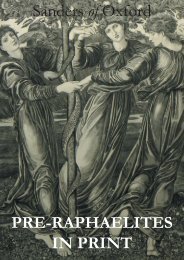«Heading» - International League of Antiquarian Booksellers
«Heading» - International League of Antiquarian Booksellers
«Heading» - International League of Antiquarian Booksellers
Create successful ePaper yourself
Turn your PDF publications into a flip-book with our unique Google optimized e-Paper software.
London Published as the Act directs Dec.r 1, 1795<br />
Image 183 x 117 mm, Sheet 207 x 125 mm<br />
mounted<br />
From An Universal System <strong>of</strong> Natural History <strong>of</strong> The<br />
Tribe Simia; Or Animals Resembling Man by Ebenezer<br />
Sibly. [26279]<br />
£35<br />
Flora<br />
From An Universal System <strong>of</strong> Natural History <strong>of</strong> The<br />
Tribe Simia; Or Animals Resembling Man by Ebenezer<br />
Sibly. [26280]<br />
£35<br />
Basilius Besler (1561 – 1629) was a respected<br />
Nuremberg apothecary and botanist, best known for his<br />
monumental Hortus Eystettensis. He was curator <strong>of</strong> the<br />
garden <strong>of</strong> Johann Konrad von Gemmingen, prince<br />
bishop <strong>of</strong> Eichstätt in Bavaria. The bishop<br />
commissioned Besler to compile a codex <strong>of</strong> the plants<br />
growing in his garden, a task which Besler took sixteen<br />
years to complete, Johann Konrad dying shortly before<br />
the work was published.<br />
Where as previous botanical art had placed an emphasis<br />
only on medical or culinary herbs, <strong>of</strong>ten crudely<br />
executed, Besler’s Hortus Eystettensis depicted 1084<br />
species including garden flowers, herbs and vegetables<br />
and exotic plants such as castor-oil and arum lilies.<br />
These were modern in concept and produced near life<br />
size in great detail.<br />
The work generally reflected the four seasons, showing<br />
first the flowering and then the fruiting stages. "Winter"<br />
was sparsely represented with a mere 7 plates. "Spring"<br />
was a season <strong>of</strong> abundance with 134 plates illustrating<br />
454 plants and "Summer" in full swing showed 505<br />
plants on 184 plates. "Autumn" closed <strong>of</strong>f the work with<br />
42 plates and 98 species.<br />
118. The Ring-tailed Maucauco<br />
Copper engraving with original hand colouring<br />
J.Pass after Johann Jacob Ihle<br />
First published in 1613, two versions were produced,<br />
cheap black and white for use as a reference book, and a<br />
luxury version without text, printed on quality paper and<br />
lavishly hand-coloured. The work was published twice<br />
more in Nuremberg in 1640 and 1713. The plates were<br />
eventually destroyed by the Royal Mint <strong>of</strong> Munich in<br />
1817.












